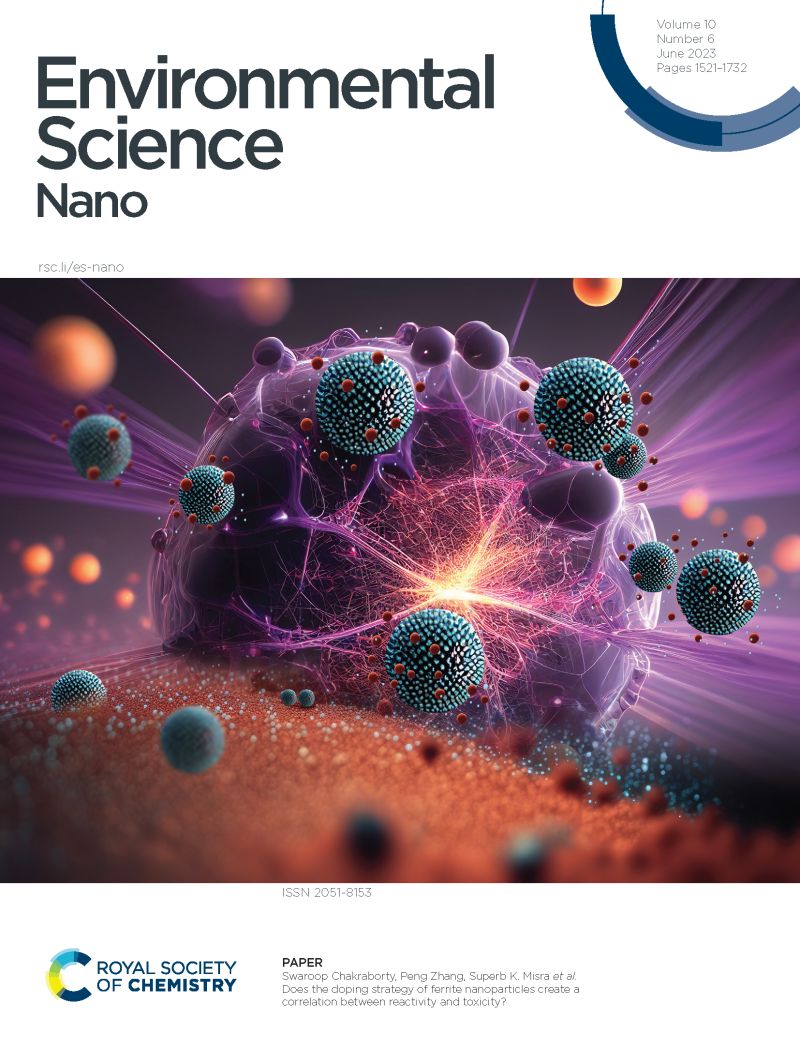Enzyme-Driven Biodegradation of Ti3C2 MXene: Unveiling Peroxidase-Mediated Pathways and Enhanced Bioaccumulation Risks in Aquatic Systems
IF 5.8
2区 环境科学与生态学
Q1 CHEMISTRY, MULTIDISCIPLINARY
引用次数: 0
Abstract
2D MXene nanosheets are increasingly attracting interest due to their promising applications in materials science and biomedicine. However, the environmental fate of MXenes, particularly their biotransformation, is poorly understood. Here, the biodegradability of Ti3C2 MXene nanosheets was investigated using a plant horseradish peroxidase (HRP)-mediated reaction. The degradation rates of Ti3C2 MXene nanosheets were determined to be first-order in both HRP and H2O2 dosage. Material characterizations and product identifications revealed that peroxidase-catalyzed the oxidation of Ti3C2 MXene in the presence of H2O2, resulting in the formation of holes on its basal plane, the generation of titanium dioxide (TiO2) nanoparticles, and the release of CO2. The assessment using Daphnia magna revealed visible toxicity and enrichment of Ti3C2 MXene to aquatic organisms, with LC50 values of pristine Ti3C2 MXene to Daphnia as 55.41, 7.24, and 2.97 mg L-1 at 48, 72, and 96 h, respectively. Substantial accumulation (74.30 μg Ti mg-1 of dry tissue) of Ti3C2 MXene by Daphnia was observed after 48 h of exposure. Furthermore, the biological effects of HRP-degraded Ti3C2 MXene products on Daphnia were examined. Although the toxicity to Daphnia was reduced, a substantial increase in the bioaccumulation of Ti3C2 MXene biodegradation products (137.36 μg Ti mg-1 of dry tissue) was observed. These findings reveal that enzymatic degradation alters the size and surface chemistry of Ti3C2 MXene, potentially changing its toxicity and altering its environmental compatibility.ti3c2mxene的酶驱动生物降解:揭示过氧化物酶介导的途径和增强的水生系统生物积累风险
二维MXene纳米片由于其在材料科学和生物医学方面的应用前景而越来越引起人们的兴趣。然而,人们对MXenes的环境命运,特别是它们的生物转化,知之甚少。本文利用植物辣根过氧化物酶(HRP)介导的反应研究了ti3c2mxene纳米片的生物降解性。在HRP和H2O2用量下,ti3c2mxene纳米片的降解率均为一级。材料表征和产物鉴定表明,过氧化酶在H2O2存在下催化Ti3C2 MXene氧化,导致其基面上形成孔洞,生成二氧化钛(TiO2)纳米颗粒,并释放CO2。结果表明,Ti3C2 MXene对水蚤具有明显的毒性和富集作用,在48、72和96 h时,原始Ti3C2 MXene对水蚤的LC50分别为55.41、7.24和2.97 mg L-1。暴露48 h后,水蚤对Ti3C2 MXene的积累量达到74.30 μg(干组织Ti mg-1)。进一步考察了酶解ti3c2mxene产物对水蚤的生物学效应。虽然对水蚤的毒性降低,但Ti3C2 MXene生物降解产物的生物积累量大幅增加(干组织中137.36 μg Ti mg-1)。这些发现表明,酶降解改变了Ti3C2 MXene的大小和表面化学性质,可能改变其毒性和改变其环境相容性。
本文章由计算机程序翻译,如有差异,请以英文原文为准。
求助全文
约1分钟内获得全文
求助全文
来源期刊

Environmental Science: Nano
CHEMISTRY, MULTIDISCIPLINARY-ENVIRONMENTAL SCIENCES
CiteScore
12.20
自引率
5.50%
发文量
290
审稿时长
2.1 months
期刊介绍:
Environmental Science: Nano serves as a comprehensive and high-impact peer-reviewed source of information on the design and demonstration of engineered nanomaterials for environment-based applications. It also covers the interactions between engineered, natural, and incidental nanomaterials with biological and environmental systems. This scope includes, but is not limited to, the following topic areas:
Novel nanomaterial-based applications for water, air, soil, food, and energy sustainability
Nanomaterial interactions with biological systems and nanotoxicology
Environmental fate, reactivity, and transformations of nanoscale materials
Nanoscale processes in the environment
Sustainable nanotechnology including rational nanomaterial design, life cycle assessment, risk/benefit analysis
 求助内容:
求助内容: 应助结果提醒方式:
应助结果提醒方式:


